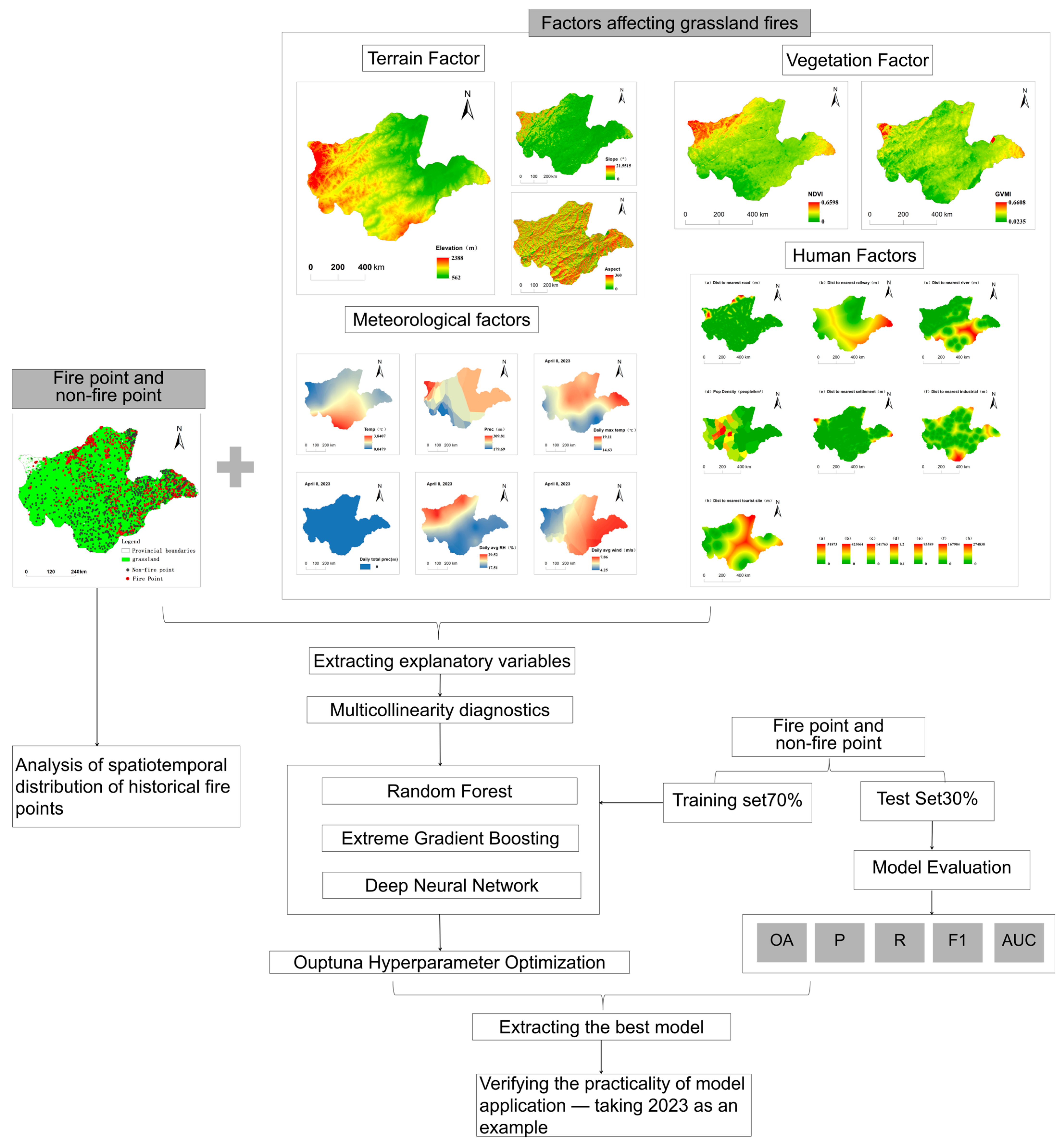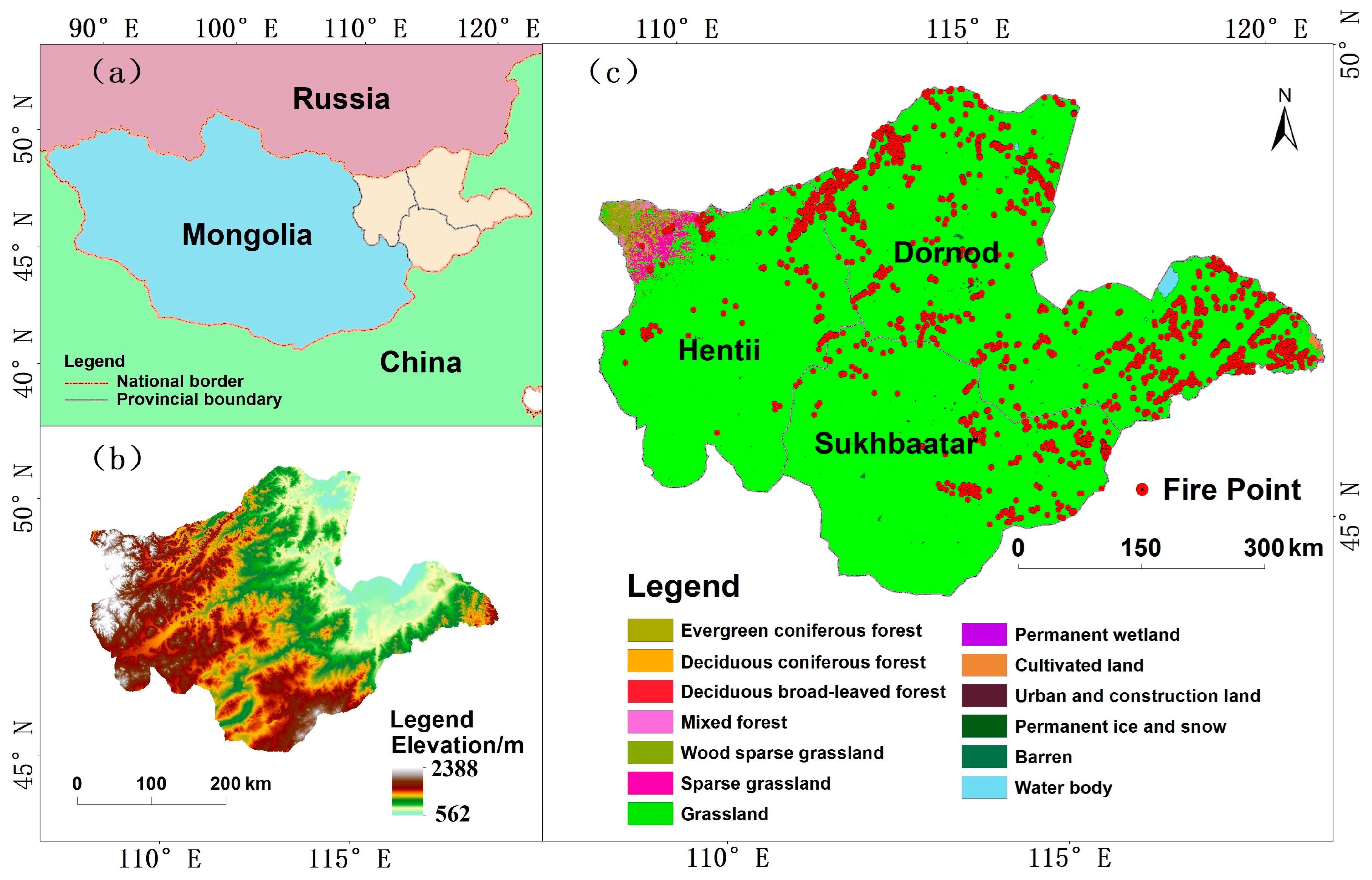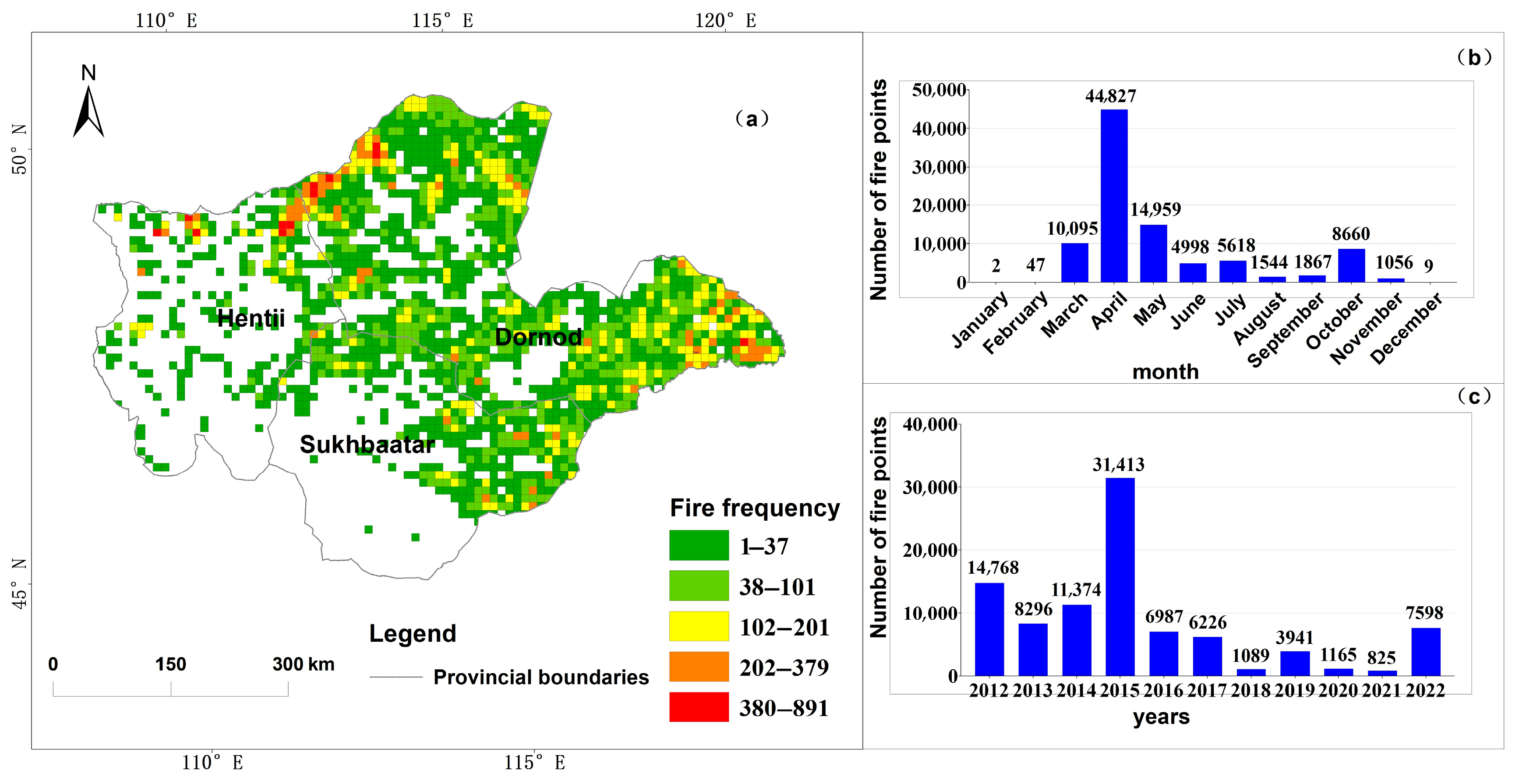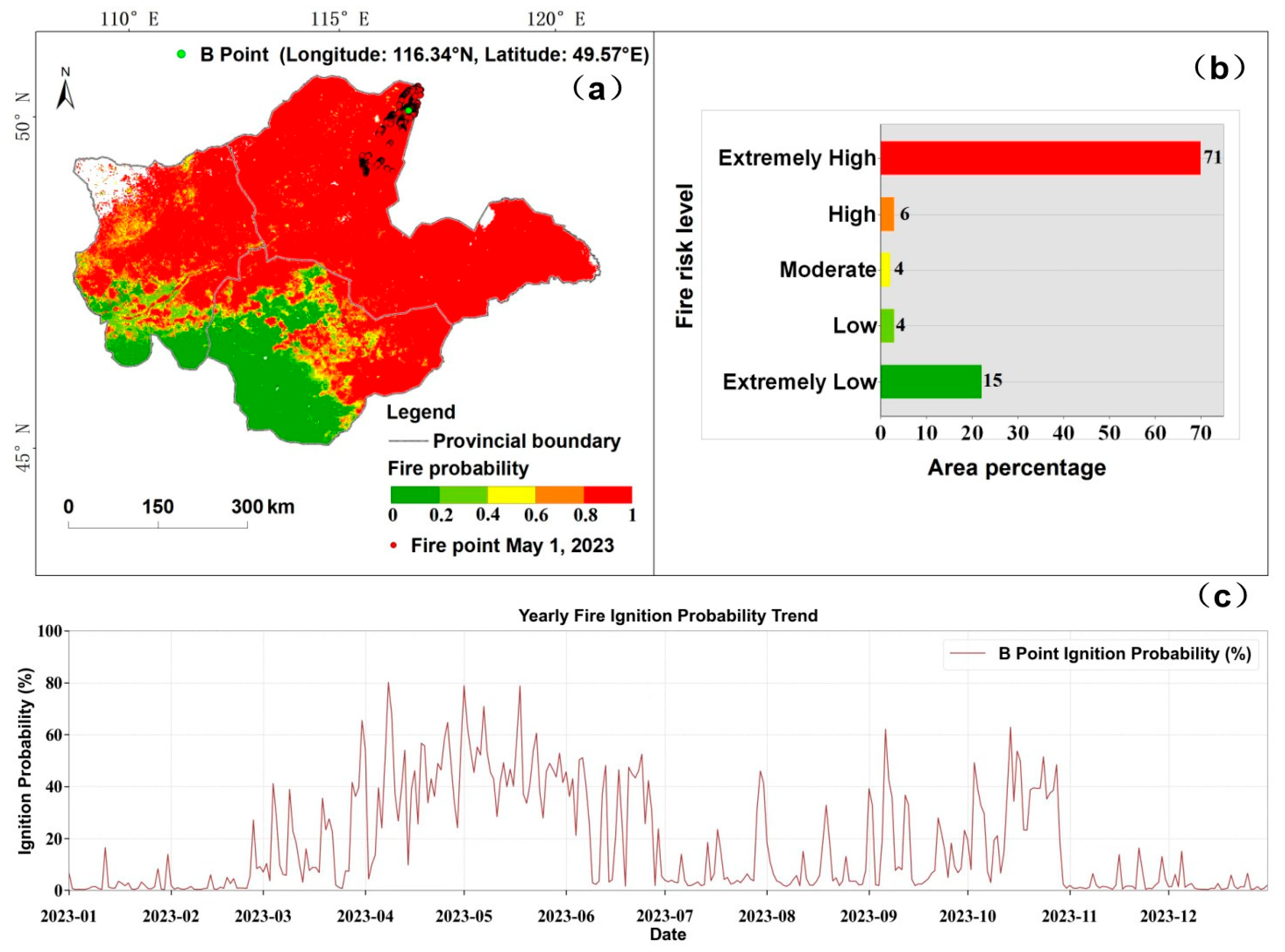Daily-Scale Fire Risk Assessment for Eastern Mongolian Grasslands by Integrating Multi-Source Remote Sensing and Machine Learning
Abstract
1. Introduction
2. Materials and Methods
2.1. Study Area
2.2. Research Data
2.2.1. Grassland Fire Data
2.2.2. Grassland Fire-Influencing Factors
- Meteorological Factors:
- Anthropogenic Factors:
- Vegetation Factors:
- Topographic Factors:
2.3. Research Methods
2.3.1. Multicollinearity Diagnosis Among Explanatory Variables
2.3.2. Grassland Fire Trend Analysis
2.3.3. Model Construction Method
2.3.4. Model Evaluation Methods
2.3.5. Interpretability Analysis
3. Results
3.1. Spatiotemporal Distribution Patterns of Fire Occurrence
3.2. Model Fitting and Evaluation
3.3. Practical Applicability of the Model
4. Discussion
4.1. Model Performance Comparison and Algorithm Selection
4.2. Drivers of Grassland Fire Occurrence
4.3. Limitations and Future Directions
5. Conclusions
- Methodological Innovation:
- 2.
- Interpretability and Driver Analysis:
- 3.
- Practical Validation:
Author Contributions
Funding
Data Availability Statement
Acknowledgments
Conflicts of Interest
References
- Petermann, J.S.; Buzhdygan, O.Y. Grassland biodiversity. Curr. Biol. 2021, 31, R1195–R1201. [Google Scholar] [CrossRef] [PubMed]
- Archibald, S.; Lehmann, C.E.; Gomez-Dans, J.L.; Bradstock, R.A. Defining pyromes and global syndromes of fire regimes. Proc. Natl. Acad. Sci. USA 2013, 110, 6442–6447. [Google Scholar] [CrossRef]
- Jones, M.W.; Abatzoglou, J.T.; Veraverbeke, S.; Andela, N.; Lasslop, G.; Forkel, M.; Smith, A.J.; Burton, C.; Betts, R.A.; van der Werf, G.R. Global and regional trends and drivers of fire under climate change. Rev. Geophys. 2022, 60, e2020RG000726. [Google Scholar] [CrossRef]
- Nandintsetseg, B.; Boldgiv, B.; Chang, J.; Ciais, P.; Davaanyam, E.; Batbold, A.; Bat-Oyun, T.; Stenseth, N.C. Risk and vulnerability of Mongolian grasslands under climate change. Environ. Res. Lett. 2021, 16, 034035. [Google Scholar] [CrossRef]
- Cai, Q.; Chen, W.; Chen, S.; Xie, S.-P.; Piao, J.; Ma, T.; Lan, X. Recent pronounced warming on the Mongolian Plateau boosted by internal climate variability. Nat. Geosci. 2024, 17, 181–188. [Google Scholar] [CrossRef]
- Fuhlendorf, S.D.; Engle, D.M.; Kerby, J.; Hamilton, R. Pyric herbivory: Rewilding landscapes through the recoupling of fire and grazing. Conserv. Biol. 2009, 23, 588–598. [Google Scholar] [CrossRef]
- Bao, Y.; Shinoda, M.; Yi, K.; Fu, X.; Sun, L.; Nasanbat, E.; Li, N.; Xiang, H.; Yang, Y.; DavdaiJavzmaa, B.; et al. Satellite-Based Analysis of Spatiotemporal Wildfire Pattern in the Mongolian Plateau. Remote Sens. 2023, 15, 190. [Google Scholar] [CrossRef]
- Chao, L.; Bao, Y.; Zhang, J.; Bao, Y.; Mei, L.; Cha, E. Effects of Vegetation Belt Movement on Wildfire in the Mongolian Plateau over the Past 40 Years. Remote Sens. 2023, 15, 2341. [Google Scholar] [CrossRef]
- Rihan, W.; Zhao, J.; Zhang, H.; Guo, X.; Ying, H.; Deng, G.; Li, H. Wildfires on the Mongolian Plateau: Identifying Drivers and Spatial Distributions to Predict Wildfire Probability. Remote Sens. 2019, 11, 2361. [Google Scholar] [CrossRef]
- Chi, W.; Zhang, H.; Xu, K.; Bao, Y. Spatiotemporal patterns and trends of the Mongolian Plateau wildfires. Nat. Inn. Asia 2017, 4, 13–25. [Google Scholar]
- Sayad, Y.O.; Mousannif, H.; Al Moatassime, H. Predictive modeling of wildfires: A new dataset and machine learning approach. Fire Saf. J. 2019, 104, 130–146. [Google Scholar] [CrossRef]
- Cao, Y.; Wang, M.; Liu, K. Wildfire Susceptibility Assessment in Southern China: A Comparison of Multiple Methods. Int. J. Disaster Risk Sci. 2017, 8, 164–181. [Google Scholar] [CrossRef]
- Yathish, H.; Athira, K.V.; Preethi, K.; Pruthviraj, U.; Shetty, A. A Comparative Analysis of Forest Fire Risk Zone Mapping Methods with Expert Knowledge. J. Indian Soc. Remote Sens. 2019, 47, 2047–2060. [Google Scholar] [CrossRef]
- Wu, R.; Hong, Z.; Du, W.; Shan, Y.; Ying, H.; Wu, R.; Gantumur, B. A Generalized Spatiotemporally Weighted Boosted Regression to Predict the Occurrence of Grassland Fires in the Mongolian Plateau. Remote Sens. 2025, 17, 1485. [Google Scholar] [CrossRef]
- Zhang, H.; Liang, Y.; Ren, H.; Ban, Q. Comparing Grassland Fire Drivers and Models in Inner Mongolia Using Field and Remote Sensing Data. Fire 2025, 8, 93. [Google Scholar] [CrossRef]
- Shapley, L.S. A value for n-person games. In Contributions to the Theory of Games II.; Kuhn, H., Tucker, A., Eds.; Princeton University Press: Princeton, NJ, USA, 1953; pp. 307–317. [Google Scholar]
- Molnar, C. Interpretable Machine Learning; Lulu.com: Morrisville, NC, USA, 2020. [Google Scholar]
- Liao, B.; Zhou, T.; Liu, Y.; Li, M.; Zhang, T. Tackling the Wildfire Prediction Challenge: An Explainable Artificial Intelligence (XAI) Model Combining Extreme Gradient Boosting (XGBoost) with SHapley Additive exPlanations (SHAP) for Enhanced Interpretability and Accuracy. Forests 2025, 16, 689. [Google Scholar] [CrossRef]
- Liu, J.; Wang, Y.; Lu, Y.; Zhao, P.; Wang, S.; Sun, Y.; Luo, Y. Application of Remote Sensing and Explainable Artificial Intelligence (XAI) for Wildfire Occurrence Mapping in the Mountainous Region of Southwest China. Remote Sens. 2024, 16, 3602. [Google Scholar] [CrossRef]
- Tonbul, H. Integrating ensemble machine learning and explainable AI for enhanced forest fire susceptibility analysis and risk assessment in Türkiye’s Mediterranean region. Earth Sci. Inform. 2024, 17, 5709–5731. [Google Scholar] [CrossRef]
- Jiang, W.; Qiao, Y.; Zheng, X.; Zhou, J.; Jiang, J.; Meng, Q.; Su, G.; Zhong, S.; Wang, F. Wildfire risk assessment using deep learning in Guangdong Province, China. Int. J. Appl. Earth Obs. Geoinf. 2024, 128, 103750. [Google Scholar] [CrossRef]
- Feurdean, A.; Vasiliev, I. The contribution of fire to the late Miocene spread of grasslands in eastern Eurasia (Black Sea region). Sci. Rep. 2019, 9, 6750. [Google Scholar] [CrossRef]
- Millington, J.D.A.; Perkins, O.; Smith, C. Human Fire Use and Management: A Global Database of Anthropogenic Fire Impacts for Modelling. Fire 2022, 5, 87. [Google Scholar] [CrossRef]
- Li, Y.; Li, G.; Wang, K.; Wang, Z.; Chen, Y. Forest Fire Risk Prediction Based on Stacking Ensemble Learning for Yunnan Province of China. Fire 2023, 7, 13. [Google Scholar] [CrossRef]
- Flannigan, M.; Cantin, A.S.; de Groot, W.J.; Wotton, M.; Newbery, A.; Gowman, L.M. Global wildland fire season severity in the 21st century. For. Ecol. Manag. 2013, 294, 54–61. [Google Scholar] [CrossRef]
- Pimont, F.; Dupuy, J.L.; Linn, R.R. Coupled slope and wind effects on fire spread with influences of fire size: A numerical study using FIRETEC. Int. J. Wildland Fire 2012, 21, 828. [Google Scholar] [CrossRef]
- Bowman, D.M.; Balch, J.; Artaxo, P.; Bond, W.J.; Cochrane, M.A.; D’Antonio, C.M.; Defries, R.; Johnston, F.H.; Keeley, J.E.; Krawchuk, M.A.; et al. The human dimension of fire regimes on Earth. J. Biogeogr. 2011, 38, 2223–2236. [Google Scholar] [CrossRef] [PubMed]
- Sharma, L.K.; Gupta, R.; Fatima, N. Assessing the predictive efficacy of six machine learning algorithms for the susceptibility of Indian forests to fire. Int. J. Wildland Fire 2022, 31, 735–758. [Google Scholar] [CrossRef]
- Liu, W.; Wang, S.; Zhou, Y.; Wang, L.; Zhu, J.; Wang, F. Lightning-caused forest fire risk rating assessment based on case-based reasoning: A case study in DaXingAn Mountains of China. Nat. Hazards 2015, 81, 347–363. [Google Scholar] [CrossRef]
- Turner, D.; Lewis, M.; Ostendorf, B. Spatial indicators of fire risk in the arid and semi-arid zone of Australia. Ecol. Indic. 2011, 11, 149–167. [Google Scholar] [CrossRef]
- Shmuel, A.; Heifetz, E. Global Wildfire Susceptibility Mapping Based on Machine Learning Models. Forests 2022, 13, 1050. [Google Scholar] [CrossRef]
- Abatzoglou, J.T.; Williams, A.P.; Boschetti, L.; Zubkova, M.; Kolden, C.A. Global patterns of interannual climate–fire relationships. Glob. Change Biol. 2018, 24, 5164–5175. [Google Scholar] [CrossRef]
- Ye, J.; Wu, M.; Deng, Z.; Xu, S.; Zhou, R.; Clarke, K.C. Modeling the spatial patterns of human wildfire ignition in Yunnan province, China. Appl. Geogr. 2017, 89, 150–162. [Google Scholar] [CrossRef]
- Chang, C.; Chang, Y.; Xiong, Z.; Ping, X.; Zhang, H.; Guo, M.; Hu, Y. Predicting Grassland Fire-Occurrence Probability in Inner Mongolia Autonomous Region, China. Remote Sens. 2023, 15, 2999. [Google Scholar] [CrossRef]
- Ceccato, P.; Gobron, N.; Flasse, S.; Pinty, B.; Tarantola, S. Designing a spectral index to estimate vegetation water content from remote sensing data: Part 1: Theoretical approach. Remote Sens. Environ. 2002, 82, 188–197. [Google Scholar] [CrossRef]
- Visner, M.; Shirowzhan, S.; Pettit, C. Spatial Analysis, Interactive Visualisation and GIS-Based Dashboard for Monitoring Spatio-Temporal Changes of Hotspots of Bushfires over 100 Years in New South Wales, Australia. Buildings 2021, 11, 37. [Google Scholar] [CrossRef]
- Fawagreh, K.; Gaber, M.M.; Elyan, E. Random forests: From early developments to recent advancements. Syst. Sci. Control Eng. 2014, 2, 602–609. [Google Scholar] [CrossRef]
- Breiman, L. Random forests. Mach. Learn. 2001, 45, 5–32. [Google Scholar] [CrossRef]
- Chen, T.; Guestrin, C. Xgboost: A scalable tree boosting system. In Proceedings of the 22nd ACM SIGKDD International Conference on Knowledge Discovery and Data Mining, San Francisco, CA, USA, 13–17 August 2016; Association for Computing Machinery: New York, NY, USA, 2016; pp. 785–794. [Google Scholar]
- Bentéjac, C.; Csörgő, A.; Martínez-Muñoz, G. A comparative analysis of gradient boosting algorithms. Artif. Intell. Rev. 2021, 54, 1937–1967. [Google Scholar] [CrossRef]
- McIntosh, L.; Maheswaranathan, N.; Nayebi, A.; Ganguli, S.; Baccus, S. Deep learning models of the retinal response to natural scenes. In Proceedings of the 30th International Conference on Neural Information Processing Systems, Barcelona, Spain, 5–10 December 2016; Curran Associates Inc.: New York, NY, USA; Volume 29, pp. 1369–1377. [Google Scholar]
- LeCun, Y.; Bengio, Y.; Hinton, G. Deep learning. Nature 2015, 521, 436–444. [Google Scholar] [CrossRef]
- Akiba, T.; Sano, S.; Yanase, T.; Ohta, T.; Koyama, M. Optuna: A next-generation hyperparameter optimization framework. In Proceedings of the 25th ACM SIGKDD International Conference on Knowledge Discovery & Data Mining, Anchorage, AK, USA, 4–8 August 2019; Association for Computing Machinery: New York, NY, USA, 2019. [Google Scholar]
- Bergstra, J.; Bardenet, R.; Bengio, Y.; Kégl, B. Algorithms for hyper-parameter optimization. In Proceedings of the 25th International Conference on Neural Information Processing Systems, Granada, Spain, 12–15 December 2011; Curran Associates Inc.: New York, NY, USA, 2011; p. 24. [Google Scholar]
- Kohavi, R. A study of cross-validation and bootstrap for accuracy estimation and model selection. In Proceedings of the 14th International Joint Conference on Artificial Intelligence—Volume 2, Montreal, QC, Canada, 20–25 August 1995; Morgan Kaufmann Publishers Inc.: San Francisco, CA, USA, 1995. [Google Scholar]
- Feurer, M.; Hutter, F. Hyperparameter Optimization; Springer International Publishing: Cham, Switzerland, 2019. [Google Scholar]
- Prechelt, L. Early stopping—But when? In Neural Networks: Tricks of the Trade; Springer: Berlin/Heidelberg, Germany, 2002; pp. 55–69. [Google Scholar]
- Probst, P.; Wright, M.N.; Boulesteix, A.L. Hyperparameters and tuning strategies for random forest. Wiley Interdiscip. Rev. Data Min. Knowl. Discov. 2019, 9, e1301. [Google Scholar] [CrossRef]
- Bernard, S.; Heutte, L.; Adam, S. Forest-RK: A new random forest induction method. In Proceedings of the Advanced Intelligent Computing Theories and Applications. With Aspects of Artificial Intelligence: 4th International Conference on Intelligent Computing, Shanghai, China, 15–18 September 2008; Springer: Berlin/Heidelberg, Germany, 2008. [Google Scholar]
- Segal, M.R. Machine Learning Benchmarks and Random Forest Regression. University of California: San Francisco, CA, USA, 2004. [Google Scholar]
- Geurts, P.; Ernst, D.; Wehenkel, L. Extremely randomized trees. Mach. Learn. 2006, 63, 3–42. [Google Scholar] [CrossRef]
- Natekin, A.; Knoll, A. Gradient boosting machines, a tutorial. Front. Neurorobot. 2013, 7, 21. [Google Scholar] [CrossRef]
- Tyree, S.; Weinberger, K.Q.; Agrawal, K.; Paykin, J. Parallel boosted regression trees for web search ranking. In Proceedings of the 20th International Conference on World Wide Web, Hyderabad, India, 28 March–1 April 2011; Association for Computing Machinery: New York, NY, USA, 2011. [Google Scholar]
- Friedman, J.H. Stochastic gradient boosting. Comput. Stat. Data Anal. 2002, 38, 367–378. [Google Scholar] [CrossRef]
- Kingma, D.P.; Ba, J. Adam: A Method for Stochastic Optimization. arXiv 2015, arXiv:1412.6980. [Google Scholar]
- Srivastava, N.; Hinton, G.; Krizhevsky, A.; Sutskever, I.; Salakhutdinov, R. Dropout: A simple way to prevent neural networks from overfitting. J. Mach. Learn. Res. 2014, 15, 1929–1958. [Google Scholar]
- Chung, J.; Gulcehre, C.; Cho, K.; Bengio, Y. Empirical evaluation of gated recurrent neural networks on sequence modeling. arXiv 2014, arXiv:1412.3555. [Google Scholar]
- Roscher, R.; Bohn, B.; Duarte, M.F.; Garcke, J. Explainable machine learning for scientific insights and discoveries. IEEE Access 2020, 8, 42200–42216. [Google Scholar] [CrossRef]
- Brenning, A. Spatial cross-validation and bootstrap for the assessment of prediction rules in remote sensing: The R package sperrorest. In Proceedings of the 2012 IEEE International Geoscience and Remote Sensing Symposium, Munich, Germany, 22–27 July 2012; IEEE: Piscataway, NJ, USA, 2012. [Google Scholar]
- Cawley, G.C.; Talbot, N.L. On over-fitting in model selection and subsequent selection bias in performance evaluation. J. Mach. Learn. Res. 2010, 11, 2079–2107. [Google Scholar]
- Abatzoglou, J.T.; Williams, A.P.; Barbero, R. Global Emergence of Anthropogenic Climate Change in Fire Weather Indices. Geophys. Res. Lett. 2019, 46, 326–336. [Google Scholar] [CrossRef]
- Jolly, W.M.; Cochrane, M.A.; Freeborn, P.H.; Holden, Z.A.; Brown, T.J.; Williamson, G.J.; Bowman, D.M. Climate-induced variations in global wildfire danger from 1979 to 2013. Nat. Commun. 2015, 6, 7537. [Google Scholar] [CrossRef]
- Forkel, M.; Druke, M.; Thurner, M.; Dorigo, W.; Schaphoff, S.; Thonicke, K.; von Bloh, W.; Carvalhais, N. Constraining modelled global vegetation dynamics and carbon turnover using multiple satellite observations. Sci. Rep. 2019, 9, 18757. [Google Scholar] [CrossRef]









| Factors | Variables | Abbreviation | Units | Spatial Resolution |
|---|---|---|---|---|
| Meteorological factors | Annual average temperature | Temp | °C | Generate 500 m grid data |
| Annual average annual precipitation | Prec | mm | Generate 500 m grid data | |
| Daily average relative humidity | Daily Avg 1 RH | % | Generate 500 m grid data | |
| Daily total precipitation | Daily total precip | mm | Generate 500 m grid data | |
| Daily maximum temperature | Daily max temp | °C | Generate 500 m grid data | |
| Daily average wind speed | Daily Avg wind speed | m/s | Generate 500 m grid data | |
| Human Factors | Distance to the nearest settlement | Dist 1 to nearest settlement | km | 500 m |
| Distance to the nearest road | Dist to nearest road | km | 500 m | |
| Distance to the nearest industrial area | Dist to nearest industrial | km | 500 m | |
| Distance to the nearest tourist site | Dist to nearest tourist site | km | 500 m | |
| Distance to the nearest river | Dist to nearest river | km | 500 m | |
| Distance to the nearest railway | Dist to nearest railway | km | 500 m | |
| Population density | Pop Density | Per/km2 | 500 m | |
| Vegetation Factor | Global vegetation wetness index | GVMI | - | 500 m |
| Normalized difference vegetation index | NDVI | - | 500 m | |
| Terrain Factor | Elevation | DEM | m | 500 m |
| Slope aspect (categorical variables) | Aspect | - | 500 m | |
| Slope | Slope | ° | 500 m |
| Slope Aspect | Aspect Angle/(°) | Serial Number |
|---|---|---|
| Gentle slope | −1 | 0 |
| North | 0–22.5/337.5–360 | 1 |
| Northeast | 22.5–67.5 | 2 |
| East | 67.5–112.5 | 3 |
| Southeast | 112.5–157.5 | 4 |
| South | 157.5–202.5 | 5 |
| Southwest | 202.5–247.5 | 6 |
| West | 247.5–292.5 | 7 |
| Northwest | 292.5–337.5 | 8 |
| Evaluation Indicators | Calculation Formula | Judging Criteria |
|---|---|---|
| Accuracy | The larger the value, the better the model performance. | |
| Recall | The larger the value, the better the model performance. | |
| Precision | The larger the value, the better the model performance. | |
| -score | The larger the value, the better the model performance. | |
| AUC | Receiver operating characteristic curve (ROC) area under the curve | The closer the value is to 1, the better the model performance is. |
| Model | Hyperparameter Name | Type | Search Scope | Optimal Value |
|---|---|---|---|---|
| n_estimators | Integer | [50, 800] step size 50 | 400 | |
| RF | max_samples | Continuous | [0.7, 0.9] | 0.8987 |
| max_depth | Integer | [10, 30] | 28 | |
| max_samples_split | Integer | [20, 60] | 20 | |
| max_features | Type | [“sqrt”, 0.3, 0.5] | sqrt | |
| max_samples_leaf | Integer | [10, 30] | 10 | |
| XGBoost | max_depth | Integer | [3, 10] | 9 |
| min_child_weight | Integer | [1, 10] | 3 | |
| subsample | Continuous | [0.6, 1.0] | 0.9097 | |
| colsample_bytree | Continuous | [0.6, 1.0] | 0.9726 | |
| reg_alpha | Continuous | [0, 10] | 0.1137 | |
| reg_lambda | Continuous | [0, 10] | 2.9459 | |
| Learning_rate | Continuous | [0.01, 0.3] | 0.1573 | |
| gamma | Continuous | [0, 5] | 0.3161 | |
| DNN | Learning_rate | Continuous | [1 × 10−5, 1 × 10−2] | 0.0040 |
| hidden_layers | Integer | [2, 5] | 4 | |
| batch_size | Integer | [128, 256, 512] | 256 | |
| dropout_rate | Continuous | [0.2, 0.6] | 0.2225 | |
| L2_reg | Continuous | [1 × 10−6, 1 × 10−3] | 8.3792 | |
| neurons | Integer | [128, 256, 512] | 512 | |
| optimizer | Type | [“Adam”, ”SGD”, “RMSprop”] | Adam | |
| activation | Type | [“relu”, ”elu”, “tanh”] | relu |
| Indicators | RF | XGBoost | DNN |
|---|---|---|---|
| Accuracy | 0.902 | 0.923 | 0.915 |
| Precision | 0.905 | 0.925 | 0.915 |
| Recall | 0.905 | 0.920 | 0.915 |
| F1-score | 0.905 | 0.925 | 0.915 |
| AUC | 0.972 | 0.984 | 0.966 |
Disclaimer/Publisher’s Note: The statements, opinions and data contained in all publications are solely those of the individual author(s) and contributor(s) and not of MDPI and/or the editor(s). MDPI and/or the editor(s) disclaim responsibility for any injury to people or property resulting from any ideas, methods, instructions or products referred to in the content. |
© 2025 by the authors. Licensee MDPI, Basel, Switzerland. This article is an open access article distributed under the terms and conditions of the Creative Commons Attribution (CC BY) license (https://creativecommons.org/licenses/by/4.0/).
Share and Cite
Na, R.; Gantumur, B.; Du, W.; Bayarsaikhan, S.; Shan, Y.; Mu, Q.; Bao, Y.; Tegshjargal, N.; Vandansambuu, B. Daily-Scale Fire Risk Assessment for Eastern Mongolian Grasslands by Integrating Multi-Source Remote Sensing and Machine Learning. Fire 2025, 8, 273. https://doi.org/10.3390/fire8070273
Na R, Gantumur B, Du W, Bayarsaikhan S, Shan Y, Mu Q, Bao Y, Tegshjargal N, Vandansambuu B. Daily-Scale Fire Risk Assessment for Eastern Mongolian Grasslands by Integrating Multi-Source Remote Sensing and Machine Learning. Fire. 2025; 8(7):273. https://doi.org/10.3390/fire8070273
Chicago/Turabian StyleNa, Risu, Byambakhuu Gantumur, Wala Du, Sainbuyan Bayarsaikhan, Yu Shan, Qier Mu, Yuhai Bao, Nyamaa Tegshjargal, and Battsengel Vandansambuu. 2025. "Daily-Scale Fire Risk Assessment for Eastern Mongolian Grasslands by Integrating Multi-Source Remote Sensing and Machine Learning" Fire 8, no. 7: 273. https://doi.org/10.3390/fire8070273
APA StyleNa, R., Gantumur, B., Du, W., Bayarsaikhan, S., Shan, Y., Mu, Q., Bao, Y., Tegshjargal, N., & Vandansambuu, B. (2025). Daily-Scale Fire Risk Assessment for Eastern Mongolian Grasslands by Integrating Multi-Source Remote Sensing and Machine Learning. Fire, 8(7), 273. https://doi.org/10.3390/fire8070273











